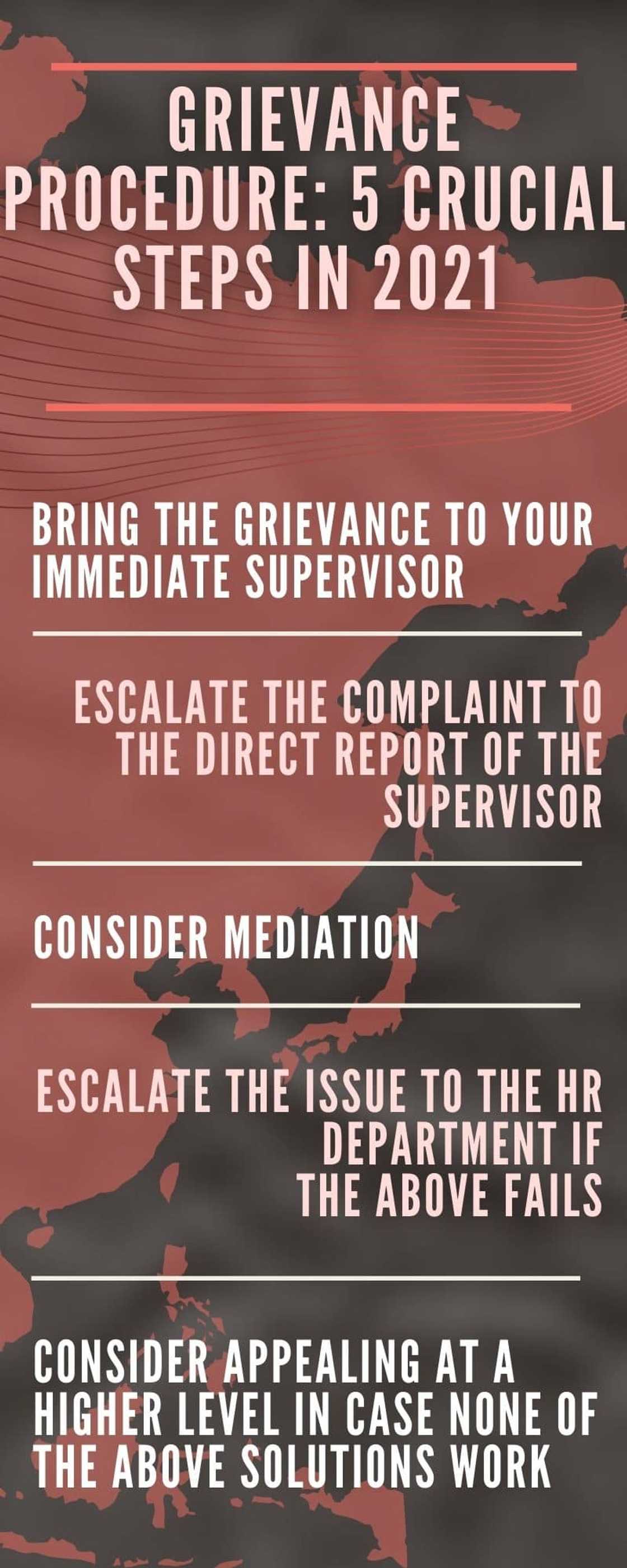Grievance procedure: 5 crucial steps in 2022 (guidelines)
As human beings, we are bound to have dissatisfactions and complaints at the workplace. When this happens, it is crucial that all parties concerned know the proper grievance procedure steps in order to resolve the issue quickly and amicably. Unfortunately, there is no stipulated SA law on grievance handling although there are guidelines.

Source: UGC
A grievance meaning, in ordinary language, refers to a concern, complaint, or any form of workplace discontentment or dissatisfaction that you may have as an employee with your employer, manager, or fellow employee that needs to be addressed by the management. This issue is easily dealt with if the appropriate procedure is followed. The common issues that may lead to grievances include work relations and environment, breach of the terms and conditions of the employment contract, equal opportunities, health and safety, and other work-related issues that affect the worker and need to be sorted by the employer. It is important to note that this process does not deal with issues related to compensation issues, unfair labour practices, demands for other benefits, or as an appeal mechanism following a disciplinary hearing.
What are the steps in the grievance procedure?
What is a formal grievance procedure? The following 5 steps of grievance procedure are the guidelines you can use when you have a complaint or when dissatisfied. According to the 1996 Constitution of the Republic of South Africa, everyone has a right to fairness at work. A well-established grievance procedure for an organization should be able to handle issues without escalation.
1. Bring the grievance to your immediate supervisor
The first step of the grievance procedure South Africa is an informal resolution with your immediate supervisor. As we all know, there is no need to escalate issues to higher authorities without trying to sort them at the lowest point first, and this also avoids insubordination issues. Usually, most companies train their supervisors and managers to deal with the common work issues in a fair and unbiased manner. At this stage, the supervisor should do all that he or she can to resolve the issue within 3 working days.
This step is also applicable if the supervisor is the source of the problem. For example, you may feel that you are getting picked on by the supervisor or that you are being treated unfairly. In that case, it is important to have a dialogue and try to get a resolution.
2. Escalate the complaint to the direct report of the supervisor
If the supervisor cannot handle the issue, he or she may take the complaint informally to someone above, such as a line manager. This can also be done formally (although not mandatory) by filling the grievance form, and the issue should be addressed within 10 working days.
3. Consider mediation
Mediation is quite crucial in most companies’ grievances procedures. Mostly, companies rely on neutral external parties to mediate on a dissatisfaction issue at work in order to ensure impartiality. Mediation is an option that should be considered at every stage if the resolution reaches a standstill. However, some situations do not warrant the use of mediation such as:
- When mediation is the first step in resolving a grievance. The first step should be an informal dialogue between the aggrieved employee and the immediate supervisor. If the complaint involves another employee, then the two employees should dialogue first preferably in the presence of the supervisor.
- When a manager turns to mediation in order to avoid handling a grievance. This especially becomes an issue when the complaint requires an investigation or a final decision about what is right or wrong. In these cases, mediation should be avoided.
- When neither of the parties has the authority to resolve the grievance. Usually, a mediator is brought in for two parties that have the power to settle the matter.
- When mediation will bring about unrealistic expectations.
4. Escalate the issue to the HR department if the above fails
At this stage, all informality is cast aside and the first step of the official channels is invoked. Here, the employee has to write a grievance letter or fill a grievance form and submit it to the HR department. According to the SA law on grievance procedure under the labour laws, the employee has to write this letter within 90 days from the time when the employee became aware of the grievance. This means that any alternative steps that are taken toward a resolution have to be closed within that period.
Once the complaint is lodged, the HR and the employer have 30 days to come up with a resolution with the employee. This time period can be extended if the parties come to a mutual agreement (in writing of course) that they should extend the time frame.
5. Consider appealing at a higher level in case none of the above solutions work
This is the highest avenue for resolution. If all the other procedures fail, then the employee can go to a higher external grievance body such as the Council for Conciliation, Mediation, and Arbitration (CCMA).
It is important to include a time limit in each of the steps above so that the issue is resolved within a reasonable period. At any stage of the grievance process, the employee is entitled to have representation during all situations to help present the case of the dissatisfied party. The representation can be a fellow employee, an official from your trade union, or anyone else who is properly certified. In the event that the employee does not have access to any of the three parties, the worker can request to bring a different companion to a certain case. Keep in mind that the employer would be well within their rights to deny this request.
What is the purpose of a grievance procedure? There are many benefits of the grievance procedure, but all in all, when the steps above are followed, they promote sound labour relations, which are needed to increase productivity at work and ensure employee satisfaction.
The grievance procedure is a rather straightforward process that every company should follow. Even though it may differ slightly in different places, the general idea of informal methods first then formal methods later holds.
DISCLAIMER: This article is intended for general informational purposes only and does not address individual circumstances. It is not a substitute for professional advice or help and should not be relied on to make decisions of any kind. Any action you take upon the information presented in this article is strictly at your own risk and responsibility!
Source: Briefly News






